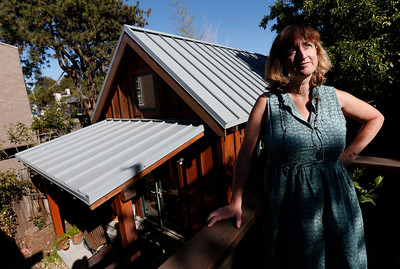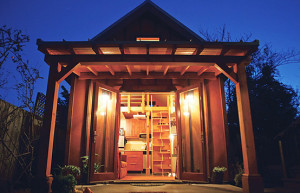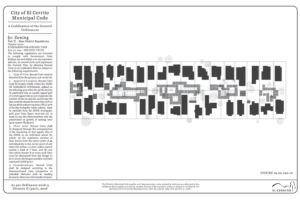
Research Summary
Project Objectives
Documents
Publications
News and Media
Blogs
Research Summary
California’s implementation of SB 375, the Sustainable Communities and Climate Protection Act of 2008, is putting new pressure on communities to support infill development. As metropolitan planning organizations struggle to communicate the need for density, they should take note of strategies that make increasing density an attractive choice for neighborhoods and regions.
The construction of self-contained, smaller second units on the lots of existing homes—either attached to the primary house, such as an above-the-garage or basement unit, or a free-standing cottage or carriage-house— can create infill without altering a neighborhood’s character. The backyard cottage at Karen Chapple’s home in the Berkeley flats is a real-life contemporary demonstration of a historic approach to increasing residential density without significantly altering a neighborhood’s character.
Project Objectives
This research examines alternative ways to scale up infill housing development.
Publications
Chapple, Karen, Somaya Abdelgany, Alison Ecker, and Sonrisa Cooper. 2017. A Solution on the Ground: Assessing the Feasibility of Second Units in San Mateo County. Berkeley, CA: Center for Community Innovation.
Chapple, Karen, Jake Wegmann, Farzad Mashhood, and Rebecca Coleman. 2017. Jumpstarting the Market for Accessory Dwelling Units: Lessons Learned from Portland, Seattle, and Vancouver. Berkeley, CA: Terner Center for Housing Innovation.
Wegmann, Jake and Karen Chapple. 2014. “Hidden density in single-family neighborhoods: Backyard cottages as an equitable smart growth strategy.” Journal of Urbanism.
Wegmann, Jake, Alison Nemirow, and Karen Chapple. 2012. “Scaling Up Secondary Unit Production in the East Bay: Impacts and Policy Implications.” IURD Working Paper 2012-05. Berkeley, CA: Institute of Urban & Regional Development.
Nemirow, Alison and Karen Chapple. 2012. “Yes, But Will They Let Us Build? The Feasibility of Secondary Units in the East Bay.” IURD Working Paper 2012-02. Berkeley, CA: Institute of Urban & Regional Development.
Wegmann, Jake and Karen Chapple. 2012. “Understanding the Market for Secondary Units in the East Bay.” Institute of Urban and Regional Development Working Paper 2012-03. University of California, Berkeley.
Chapple, Karen, Jake Wegmann, Alison Nemirow, & Colin Dentel-Post. 2011. Yes in My Backyard: Mobilizing the Market for Secondary Units . Berkeley, CA: Center for Community Innovation.
Chapple, Karen. 2011. “Hidden Density”: The Potential of Small-Scale Infill Development. IURD Policy Brief 2011-02. Berkeley, CA: Institute of Urban & Regional Development.
Wegmann, Jake, Nemirow, Alison, and Karen Chapple. 2012. “Scaling Up Secondary Unit Production in the East Bay: Impacts and Policy Implications.” IURD Working Paper 2012-05. Berkeley, CA: Institute of Urban & Regional Development.
Berkeley’s backyard cottages(a historical overview);
Secondary Dwelling Units (also known as accessory dwelling units) in the East Bay (potential and impact);
Energy efficiency and distributed generation (facts and figures).
News and Media
One Answer to the Lack of Affordable Apartments Might Begin at Home (The Washington Post)
Building a Granny Flat? Not So Fast (San Jose Mercury News)
States Reduce Regulatory Barriers for Affordable Housing (Evidence Matters)
Granny Units Seen As Solution to Bay Area’s Tight Housing Crunch (San Jose Mercury News)
Affordable Housing 101: Why Not Build More Granny Units? (San Jose Mercury News)
Berkeley’s Backyard Tiny House Helps with Income, Landscape Karen Chapple interview by Kirsten Dirksen, Fair Companies
Thuy Vu interviews Professor Karen Chapple about ADUs on KQED Story starts at 17:30.
IURD Associate Director Karen Chapple Winner of One of the 2011 Eco Awards “The Delaware House Wins for: Providing eco-chic housing, without building up or sprawling out.” (Diablo Magazine)
Backyard Cottages Sprout Like Mushrooms…Karen Chapple, a city planning professor at the University of California, Berkeley, says she was intrigued by the burgeoning trend and built her own backyard cottage this year — as a class project, no less — to see the feasibility of backyard cottages as affordable housing options in the Bay Area.
Local Cottage Stands for Affordability and Energy Efficiency Eighteen blocks west of UC Berkeley, a cottage standing in a professor’s backyard exemplifies a new option for Bay Area affordable housing, consisting of a low-cost, energy-efficient dwelling strategically placed near a major transit corridor.
Berkeley tests concept of backyard cottage…Karen Chapple, director of the Center for Community Innovation, leads a study funded by the University of California Transportation Center “to determine how many accessory homes could be built around five Bay Area Rapid Transit stations, and how they might affect the local economy.” Berkeley has as many as 4,000 backyard cottage infill sites, according to the study’s preliminary findings. A metropolitan area could have hundreds of thousands of such sites…(Roger K. Lewis, “Shaping the City” column, Washington Post)
Berkeley zero net energy cottage deserves study Karen Chapple’s just-built second home looks exactly like what it is: a cottage that packs 450 square feet of living space into a traditional shell with a pitched roof, warm wooden walls and a shaded front porch. Old news – except that it sits tucked behind a century-old bungalow on a quiet Berkeley block with neighbors close on either side, stealth infill that in its own discreet way deserves study by every city where the need for housing outstrips the supply of obvious land. (John King, SF Chronicle)
Small, cozy cottage may start new trend Berkeley is hoping small houses will make a big difference in the city’s effort to accommodate its growing population. … It’s a backyard cottage, also known as an in-law unit. “People walk in and say this has such a sense of place,” says Karen Chapple. … She’s a city planning professor at UC Berkeley and this was her way to not only add value to her property, but to help accommodate a growing population and curb suburban sprawl. “We need to lower our energy costs as a society. We need to be more sustainable. So how are we going to get there? Well this is one strategy that is not obtrusive, we call it hidden density or invisible density,” says Chapple. (ABC7 News)
Little House Could Mean Big Environmental and Housing Gains Backers of green friendly second unit in Berkeley see potential in BART station neighborhoods. (El Cerrito Patch)
A city looks for big solutions in little – very little – houses (Berkeleyside)
Blogs
The Blocked Market for Density and Affordable Housing
Other Documents
Infilling California: Tools and Strategies for Infill Development
This seminar-lecture series sheds light on how to advance infill development in California as a viable alternative to urban sprawl. Speakers discuss ways to address challenges and emerging opportunities for infill as California’s economic and demographic conditions and environmental mandates change. As part of this series, Karen Chapple presented her research on accessory dwelling units in the Bay Area: “Hidden” Density: The potential of small-scale infill development
Read the associated policy brief here.
Dense and Sensibility: Subtle Design and Policy for Accessory Dwelling Units
Benejam’s thesis explores “the subtle,” the delicate complexity between the generic’s dullness and the iconic’s flagrancy, as a design language to rethink ADUS. It argues that this transformation in concept brings two potential benefits—increased present-day buildability. and a potential starting point for incremental densification of the Bay Area’s inner ring suburbs.

